Machairodus aphanistus
231231Machairodus aphanistus (Machairodus aphanistus (Kaup, 1832))
Order: Carnivora
Family: Felidae
Subfamily: †Machairodontinae
Tribe: †Machairodontini
Genus: †Machairodus
Temporal range: Miocene-Pliocene in Europe, Asia, Africa and North America
Dimensions: 1,8 m in length, 95 cm in height, 120-220 kg of weight
Machairodus aphanistus belonged to the genus Machairodus of large machairodontine saber-toothed cats that lived in Europe, Asia, Africa and North America during the Miocene through Pleistocene living from 11.6mya—126,000 years ago, existing for approximately 11.5 million years. The fossil species assigned to the genus Machairodus were divided by Turner into two grades of evolutionary development - M. aphanistus and the North American "Nimravides" catacopis representing the more primitive grade, and M. coloradensis and M. giganteus representing the more derived grade. The characteristics of the more advanced grade include a relative elongation of the forearm and a shortening of the lumbar region of the spine to resemble that in living pantherine cats. These trends would be taken further in Homotherium, which is thought to have evolved from Machairodus.
The skull of Machairodus was noticeably narrow compared with the skulls of modern pantherine big cats, and the orbits were relatively small. The canines were long, thin and flattened from side to side but broad from front to back like the blade of a knife, as in Homotherium. The front and back edges of the canines were serrated when they first grew, but these serrations were worn down in the first few years of the animal's life.There was marked sexual dimorphism in Machairodus aphanistus, with males much larger than females.
The scimitar-tooth cat Machairodus aphanistus was a successful, lion-sized felid that entered Europe during the early Vallesian as part of an immigration wave of Eastern mammal species often known as the “Hipparion datum”. It soon became widespread, and seems to have been the top predator in the European mammalian faunas of its time, apparently displacing endemic carnivores such as the large amphicyonids and barbourofelines. However, despite its wide distribution, M. aphanistus has traditionally been known from remarkably fragmentary remains. This paucity of material has precluded a deeper insight into the morphology, adaptations, evolution and ecology of this carnivore. The main characteristics of M. aphanistus as defined by previous authors were usefully summarized as follows by Sotnikova (1992): small lower incisors arranged in a straight row, large lower canines, a small diastema between the lower canine and large premolars with a complete set of accessory cusps, a well developed metaconid-talonid complex on the lower carnassial, mandibular ramus thick and high, an undeveloped mandibular flange, an upper carnassial with a distinct protocone and preparastyle and all teeth probably serrated. As may be noted, this informal diagnosis is based strictly on characters of the dentition
and anterior mandible, which were almost the only parts of the animal’s anatomy known at that time. However, the recently discovered site of Batallones-1, a carnivore trap of late Vallesian age near Madrid in central Spain, is providing
an unprecedented wealth of M. aphanistus fossils, including complete skulls and postcrania.
Social behavior is also indeterminable but may have paralleled that in modern feline species. Machairodus aphanistus is associated with faunas typical of an open plain environment and may have had a life-style similar to that of a modern lion. Machairodus aphanistus could have hunted in large packs or in small groups, maybe mating pairs. Large packs would have been beneficial in bringing down the large prey but would have meant more mouths to feed requiring more time pursuing prey. The array of prey animals available varied in size from creatures larger than buffalo such as large giraffids to medium-sized fast-running antelope. Cooperative hunting would have been more advantageous in capturing both large and small prey, using more muscle to take down the large prey and possibly using more successful ambush tactics for the small prey.
Machairodus aphanistus (Machairodus aphanistus (Kaup, 1832))
Order: Carnivora
Family: Felidae
Subfamily: †Machairodontinae
Tribe: †Machairodontini
Genus: †Machairodus
Temporal range: Miocene-Pliocene in Europe, Asia, Africa and North America
Dimensions: 1,8 m in length, 95 cm in height, 120-220 kg of weight
Machairodus aphanistus belonged to the genus Machairodus of large machairodontine saber-toothed cats that lived in Europe, Asia, Africa and North America during the Miocene through Pleistocene living from 11.6mya—126,000 years ago, existing for approximately 11.5 million years. The fossil species assigned to the genus Machairodus were divided by Turner into two grades of evolutionary development - M. aphanistus and the North American "Nimravides" catacopis representing the more primitive grade, and M. coloradensis and M. giganteus representing the more derived grade. The characteristics of the more advanced grade include a relative elongation of the forearm and a shortening of the lumbar region of the spine to resemble that in living pantherine cats. These trends would be taken further in Homotherium, which is thought to have evolved from Machairodus.
The skull of Machairodus was noticeably narrow compared with the skulls of modern pantherine big cats, and the orbits were relatively small. The canines were long, thin and flattened from side to side but broad from front to back like the blade of a knife, as in Homotherium. The front and back edges of the canines were serrated when they first grew, but these serrations were worn down in the first few years of the animal's life.There was marked sexual dimorphism in Machairodus aphanistus, with males much larger than females.
The scimitar-tooth cat Machairodus aphanistus was a successful, lion-sized felid that entered Europe during the early Vallesian as part of an immigration wave of Eastern mammal species often known as the “Hipparion datum”. It soon became widespread, and seems to have been the top predator in the European mammalian faunas of its time, apparently displacing endemic carnivores such as the large amphicyonids and barbourofelines. However, despite its wide distribution, M. aphanistus has traditionally been known from remarkably fragmentary remains. This paucity of material has precluded a deeper insight into the morphology, adaptations, evolution and ecology of this carnivore. The main characteristics of M. aphanistus as defined by previous authors were usefully summarized as follows by Sotnikova (1992): small lower incisors arranged in a straight row, large lower canines, a small diastema between the lower canine and large premolars with a complete set of accessory cusps, a well developed metaconid-talonid complex on the lower carnassial, mandibular ramus thick and high, an undeveloped mandibular flange, an upper carnassial with a distinct protocone and preparastyle and all teeth probably serrated. As may be noted, this informal diagnosis is based strictly on characters of the dentition
and anterior mandible, which were almost the only parts of the animal’s anatomy known at that time. However, the recently discovered site of Batallones-1, a carnivore trap of late Vallesian age near Madrid in central Spain, is providing
an unprecedented wealth of M. aphanistus fossils, including complete skulls and postcrania.
Social behavior is also indeterminable but may have paralleled that in modern feline species. Machairodus aphanistus is associated with faunas typical of an open plain environment and may have had a life-style similar to that of a modern lion. Machairodus aphanistus could have hunted in large packs or in small groups, maybe mating pairs. Large packs would have been beneficial in bringing down the large prey but would have meant more mouths to feed requiring more time pursuing prey. The array of prey animals available varied in size from creatures larger than buffalo such as large giraffids to medium-sized fast-running antelope. Cooperative hunting would have been more advantageous in capturing both large and small prey, using more muscle to take down the large prey and possibly using more successful ambush tactics for the small prey.

-797x638.jpg)
-797x638.jpg)
-70x56.jpg)
-70x56.jpg)
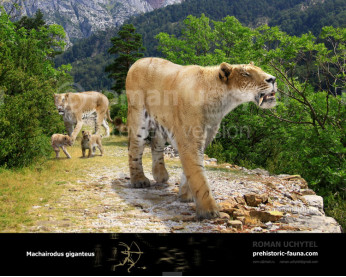
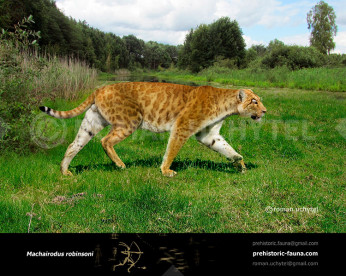
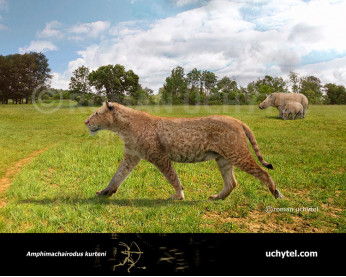
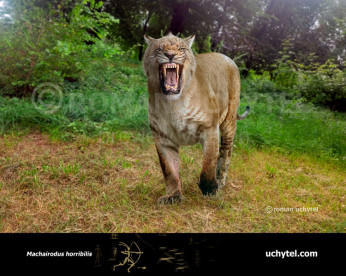
-346x277.jpg)
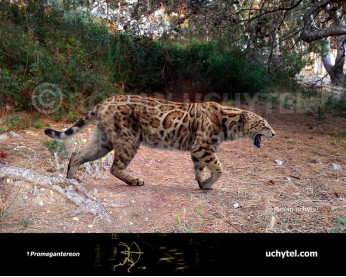
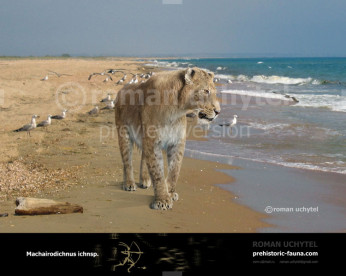
-lahayishupup-346x277.jpg)